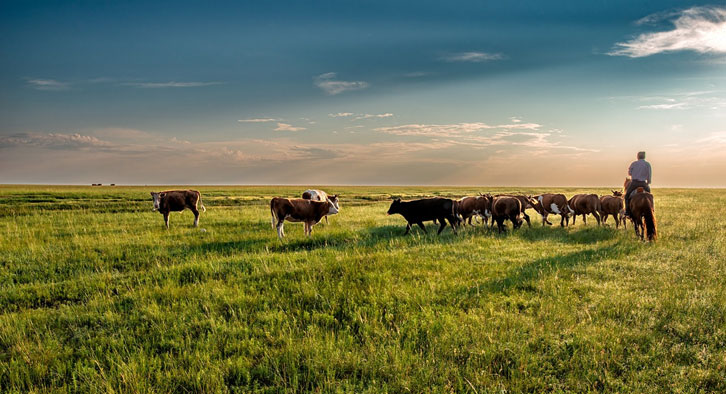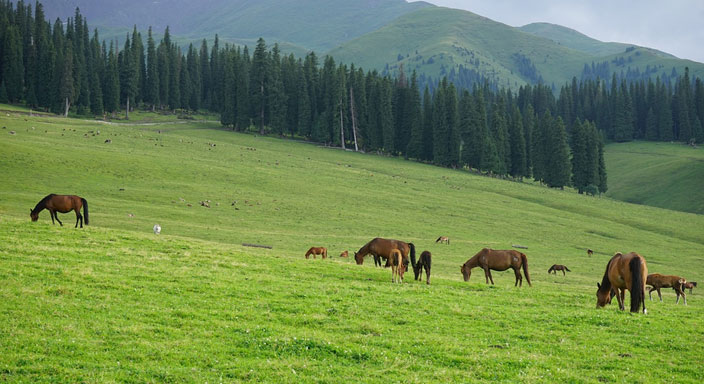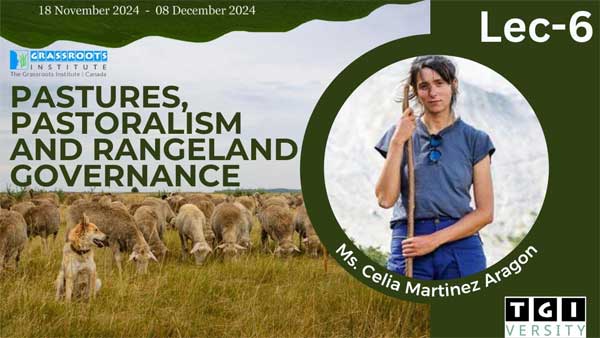Unit 2.4: Traveling through Landscapes
Instructor: Prof. Abdelaziz Karamalla Gaiballa
Field Practitioners: Ms. Celia Alba Martinez Aragon
In this Unit 2.4, let us start with establishing a shared understanding about the travelling through landscapes, landscape management its importance, problems and challenges and to create a sound understanding and clear picture of it. Let us read the following:
2.4.1 Understanding Landscape Concept
Landscapes are spatially heterogeneous geographic areas, characterized by diverse interacting patches or ecosystems, ranging from relatively natural terrestrial and aquatic systems such as forests, grasslands, and lakes to human-dominated environments including agricultural and urban settings.
Integrated landscape management is a way of managing a landscape that brings together multiple stakeholders, who collaborate to integrate policy and practice for their different land use objectives, with the purpose of achieving sustainable landscapes. It recognizes that, for example, one river basin can supply water for towns and agriculture, timber and food crops for smallholders and industry, and habitat for biodiversity; the way in which each one of these sectors pursues its goals can have impacts on the others. The intention is to minimize conflict between these different land uses’ objectives and ecosystem services) Juan, 2021).
Landscape Approaches:
According to GIZ (2019), landscape approaches apply a broad range of tried and tested strategies and methods for the sustainable management of natural resources (e.g. forest landscape restoration, integrated landscape management, sustainable land management, land degradation neutrality, watershed development, agroforestry, integrated rangeland management and crop-livestock integration systems. Landscape approaches recognize the interconnections between people and nature in places where productive land uses such as agriculture, livestock and mining compete with environmental and biodiversity goals. Such systems-based approaches aim to improve the allocation and management of land to simultaneously achieve social, economic and environmental objectives, while preserving valuable ecosystems and the essential services they provide.
The concept of Integrated Landscape Management (ILM) as one of landscape management approaches has come as one of the global development agenda in recent years. Although may understood in different ways, there is a common understand that integrated approaches are focusing on challenge of sustaining a growing human population, preventing biodiversity loss, and adapting to climate change. Based on this mountain pastoralism should be considered as one of main land uses to be considered by ILM.

Photo Courtesy: Kanenori (Pixabay.com)
It is generally accepted that integrated landscape approaches are concerned with improving land use practice, governance and decision-making in order to reconcile environmental and developmental objectives across scales. Such landscape approaches have gained renewed interest in recent years from the research, policy and donor communities due to the conceptual appeal of better harmonizing traditionally conflicting land use agendas. A key distinction between landscape approaches and more sectorial approaches to land management is the transition from a focus on project-oriented actions typically delivered in a short-term, unidirectional and top-down manner toward longer-term process-oriented activities that are devised and negotiated in a collaborative manner (Reed et al., 2020).
Successful ILM will require ensuring that, interests of all stakeholders are fully considered in the integrated landscape management framework. This will help empowering of marginalized groups that are usually not involved decision-making processes, while ensuring that landscape solutions fully correspond with local practices and knowledge.
Mandatory Quiz: [Click Here]
2.4.2 Pastoralism and Landscape
In general, landscape is an expression of variability, pastoralism takes advantage of the variability in potential inputs, which are maximized and turned into actual inputs by matching it with the variability or “flexibility” or “optionality” (FAO, 2021). Livestock mobility depends on large, usually commonly owned landscapes, knowledge of ecosystem productivity, and on pastoralists’ ability to negotiate access to resources. Traditional institutions and social cohesiveness, which once helped pastoralists regulate natural resource use and survive periods of stress, are now being eroded, but continue to play a significant role in natural resource use and conservation. Pastoralists manage their rangelands using strategies such as water development, bush clearing, tree restoration and protection, and the use of fire, all of which contribute to conservation ILM. Pastoralists’ landscapes are like a web held together by different threads and threats (Barrow et al., 2007).

Photo Courtesy: Okeyzhang (Pixabay.com)
National policies usually favor sectorial approaches to conservation because of how nation states and governments operate. Adopting ILM approaches and fostering integrated natural resource management can help. Such policy understanding hinges on pastoralists having secure rights to and responsibilities for their landscapes and their ability to defend these landscapes from expropriation and unsustainable use.
It is generally accepted that integrated landscape approaches are concerned with improving land use practice, governance and decision-making in order to reconcile environmental and developmental objectives across scales. Such landscape approaches have gained renewed interest in recent years from the research, policy and donor communities due to the conceptual appeal of better harmonizing traditionally conflicting land use agendas. A key distinction between landscape approaches and more sectorial approaches to land management is the transition from a focus on project-oriented actions typically delivered in a short-term, unidirectional and top-down manner toward longer-term process-oriented activities that are devised and negotiated in a collaborative manner (Reed et al., 2020).
Mandatory Quiz: [Click Here]
Essential Watch (Video) 1
Conservation and Sustainable Management of Rangelands - IUCN Pastoralists and their rangeland landscapes are neglected in terms of policy and investment and require a major effort to raise their visibility. This video presentation was prepared for a Special Symposium of the Society for Rangelands Management in 2017.
Copyright: YouTube
Case Study: Social and Ecological Constraints on Decision Making by Transhumant Pastoralists: A Case Study from the Moroccan Atlas Mountains
Task and Instructions for Students
Download PDF file of the Case Study. Read thoroughly and ensure a good understanding about necessity and means of considering different causative factors when analysing issues related to transhumant migration decisions and their influence by ecological and socioeconomic conditions.
https://www.researchgate.net/publication/233850797_Social_and_ecological_constraints_on_decision_making_by_transhumant_pastoralists_A_case_study_from_the_Moroccan_Atlas_Mountains
This is a Case Study from the Moroccan Atlas Mountains, focusing on social and ecological Constraints on decision making by transhumant’ pastoralists, showing that transhumant migration decisions are dependent on both ecological and socioeconomic conditions. The key ecological factor that drives decision making of transhumant pastoralists is fodder availability. Furthermore, harsh climate in the mountains limits access to mountain pastures during autumn and winter months while during summer the arid lowlands become too hot for the herders and their animals. Individual decisions allow for flexible adaptation within the framework of the tribal and ecological settings, taking into account risk control, social networks, the arrangement of tribal territories and access to local markets. This result applies to mountain pastoralism, which is characterized by distinguished landscapes.
Moving Across Landscapes
Mobility as stated is a movement practiced based on rich in-depth knowledge and inherited experience about when to move and where to move and how long to stay and what practices to adopt. Pastoralism as a land use practice should be accommodated within the framework of landscape management.
Pastoralists’ movement across landscape is one of the land use practices of the ILM. Integrated landscape management is a way of managing a landscape that brings together multiple stakeholders, who collaborate to integrate policy and practice for their different land use objectives, with the purpose of achieving sustainable landscapes. An example is that, one river basin can supply water for towns and agriculture, timber and food crops for smallholders and industry, and habitat for biodiversity; the way in which each one of these sectors pursues its goals can have impacts on the others. The intention is to minimize conflict between these different land use objectives and ecosystem services (Juan et al., 2021).
Scaling up SLM in pastoral landscapes focuses on adapting successful policies and programs that can reach greater number of pastoralists and communities. Institutional and policy changes are required to create an enabling environment to promote adoption of SLM (Basupi et al., 2019).
When practiced sustainably, pastoralism also encourages plant and landscape diversity when pastoralism uses native livestock breeds and relies on mixed fodder types, a number of benefits are realized for plant and landscape diversity. Compared to large scale enclosed grazing practices; pastoralism can be much closer to the grazing patterns of wildlife, thereby mimicking natural ecosystem interactions and functional roles. For example, on the Island of Islay off the Scottish coast, traditional cattle herding makes use of bogs, heaths and grasslands without exerting too much pressure on any one landscape or attempting to convert this mosaic of landscapes into a single ecosystem type. When compared to many agricultural practices elsewhere that extensively drain wetlands in order to convert them to croplands, the contribution of pastoralism to plant and landscape diversity becomes clear (CBD, 2010).
Essential Watch (Video) 2
The video is presented by a Doctoral researcher, explaining a research where pastoralists in Kachchh, Gujarat, move around with the seasons and temporality plays a big role in their lives. Paying attention to temporality helps to reveal the intersections between pastoralists and other systems and actors, and challenges conventional linear views of about progress and modernity. In this, it reflect how pastoralist manage their movement along landscape
Watch Video
Task and Instruction for Students
The students are requested to develop a good understanding on pastoralists’ movement and intersections between their practices and other systems and actors as the video shows, compared with similar cases and experience in your country or region.
Answers/Feedback of Students:
M2 Responses Students4
Livestream Zoom Session with Ms. Celia Alba Martinez Aragon
Topic: Moving Across Landscapes
Date: 28 November 2024
Time: 3 pm Central European Time (CET)
Zoom Link: 886 7898 3070
Recorded Video: https://youtu.be/XscKx-FRioU
Zoom Chat Text | PPT File
Before attending the above Livestream Zoom Session, all the students are advised to read the Case Study on Transhumance.
Essential Readings:
Akasbi, Z., Oldeland, J., Dengler, J. and Finckh, M. (2012). Social and ecological
constraints on decision making by transhumant pastoralists: A case study from the Moroccan Atlas Mountains. Journal of Mountain Science, 9: 307-321. https://doi.org/10.1007/s11629-009-2320-8.
Barrow, E., Davies, J., Babiker, M., Dirie, N., Gebru, G., Matiru, V.Olenasha, W.,
Rugadya, M. and McGahey, D. (2007). Pastoralism as Conservation in the Horn of Africa. Nairobi: International Union for Conservation of Nature, p.20.
CBD (2010). Pastoralism, Nature Conservation and Development: A Good Practice
Guide- Convention on Biological Diversity, Montreal, Canada. ISBN: 92-9225-162-7. https://www.cbd.int/development/doc/cbd-good-practice-guide-pastoralism-booklet-web-en.pdf
FAO (2021). Pastoralism making variability work. FAO Animal Production and
Health /paper 185. http://www.fao.org/3/cb5855en/cb5855en.pdf
GIZ (2019). Landscape Approaches Background paper.
https://www.giz.de/de/downloads/giz2023-en-landscape-approaches-background-paper.pdf
Reed, J., Ros-Tonen, M. and Sunderland, T. (2020). Operationalizing integrated
landscape approaches in the tropics. Center for International Forestry Research (CIFOR), Jakarta, Indinesia. https://doi.org/10.17528/cifor/007800.
Velasco-Muñoz, J., Aznar-Sánchez, F., López-Felices, A. and García-Arca, D.
(2021). Sustainable land Use and Management. Elsevier, pp.179-197. ISBN: 978012824342.






